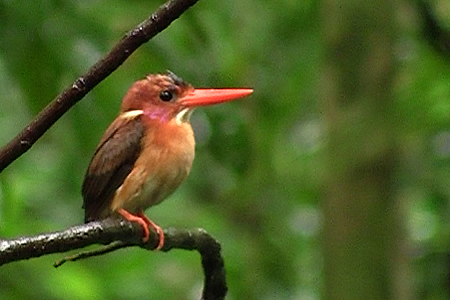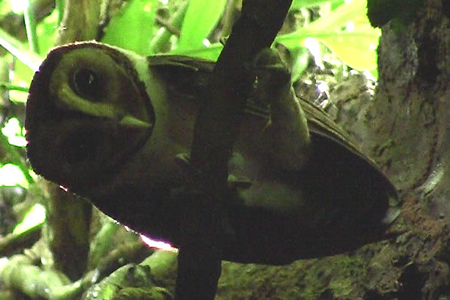

| The benefits of a good guide | |
Tobelo (Indonesia), May 2nd 2012
|
|
|
|
|
Four years ago we brought our first visit to Tangkoko National Park in the very north-eastern part of the Indonesian island Sulawesi. Not many visitors come this far. Most people, who come in this area of Sulawesi, are divers who come to the fantastic Bunaken Marine Park, which must be one of the best places to dive in Asia. Besides that, you will meet some of the more adventurous backpackers and of course birdwatchers, who are attracted by a couple of degraded national parks that still offer the opportunity to see some special Sulawesi species. These birdwatchers, often men in their sixties or seventies, arrive on expensive birding trips and are focussed to see between 200 and 300 species in around 18 days. But this will become more and more difficult because the forests are still disappearing in an alarming rate. We have always a lot of respect for these older birdwatchers because they travel to remote corners of the earth, while most others spent their days on this age behind the geraniums of their elderly homes. And many of the places they visit can only be visited if you accept basic travel circumstances and rough conditions in the park. And they do this just to see birds; something that many people won’t understand. But we, we understand this, because we often do the same, but only in an individual way. Many people have the opinion that bird watching is an activity for old men. Of course, we do not share this opinion. If you tell somebody that you go watching bears in Alaska, tigers in India or lions in Africa, people will say that it is cool and adventurous. But if you say that you will go to the misty tropical jungle of Sulawesi to search for the Sulawesi Dwarf-kingfisher, than people won’t have the same opinion. And that is a pity, because if you are also interested in smaller things in the forest, like birds, plants or insects, a visit to a park is never disappointing. And birds can be very spectacular too. We saw birds in Asia that are so spectacular, that even somebody without any interest of birds can’t ignore that these birds are a great piece of nature. We often see the same thing happening among divers. Some divers are only interested in the ‘big’ creatures in the sea like sharks, schools of barracuda’s or huge manta rays. And if they don’t see any of these animals on a dive, they will find the dive disappointing. But if you are also interested in smaller creatures like nudibranches, crabs, shrimps or coral, every dive will be worthwhile. |
|
 |
|
The Sulawesi Dwarf-kingfisher |
|
So, we were for the second time in Tangkoko National Park. Last time when we were here, we were unlucky that we arrived on the same time as a group of Bird Tours Asia, one of the high end bird watch organisations for the UK. The result was that all good guides were booked, which meant that we had to visit the park with non-specialised guide. This year we visited Tangkoko in the low season (high season is from July till October). All guides were available and we could pick the one we liked. We heard from other bird watchers that Samuel is the man to have, so we headed to the Mama Roos home stay, because this is the place Samuel is linked to. And as expected, we were the only guests when we checked in and we immediately made sure that Samuel would be the guide to take us to the park. It is mandatory to take a guide into the park. Tangkoko has around 30 guides, of which only five are specialised in bird watching. Other guides are mainly there to take visitors to the Tarsier tree to see the little creature with the big eyes, or to take to one of the Black Crested Macaque groups that roam the park. It is not going well with these Macaques. We heard from a Swiss researcher in the park, occupied with the conservation of these threatened species, that he expects that the Black Crested Macaque will be disappeared from the globe in less than 10 years; continuing deforestation and the fact that some Indonesians still like to eat bush meat, makes the dying out of this Macaque a serious scenario. Samuel was our guide in Tangkoko NP for two consecutive days. We saw a lot of very special bird species. We were extremely happy with the Kingfishers because we like this species very much. We saw the Green-backed Kingfisher, the Sulawesi Dwarf-kingfisher, the Lilac-cheeked Kingfisher and the Great-billed Kingfisher. Other beautiful species were the Isabeline Bush-hen, the Red-backed Thrush, the Crested Myna, the Sulawesi Dwarf Hornbill, and many others. Samuel did his utmost best to show us the most special species of the park. His eyes and ears are extremely well developed. Even the heavy rain didn’t influence his motivation and drive to show us the birds. |
|
 |
|
The rare Minahasa Masked-owl |
|
| Many bird watchers are interested in owls and other night birds. Night birds are difficult to see during the daylight hours, because during the day, they hide themselves in the darker places of the forest, often between the leaves or in hollow trees. But the fanatic bird watcher has a solution for this. During the evening when it is dark, he goes to the forest with recordings of the night birds. The idea is to lure the birds with recordings of the specific birds. Some birds are very territorial and will come to take a look to see of its territory is violated by a competitor. Others will think that a female bird arrived and will come to see if she is interested in further advances. When the bird watcher thinks that he located the bird by his call in one of the nearby trees, he will use a powerful spotlight to ‘freeze’ the bird to prevent that it flies away; the ’perfect’ moment to make a photograph of the bird. However, this is not the way we want to do bird watching. We never use recordings. The only things we use are our ears, eyes, one pair of binoculars and sometimes a good guide.
Samuel told us that he doesn’t like to use tapes either. That’s why he invested a lot of time to find out where the night birds are hiding during the daylight hours. He knows the different territories of some owl and has for this reason a rough indication of where the birds are. After a lot of searching, we eventually found the daylight resting places of the Ochre-bellied Boobook and the Minahasa Masked-owl. After two great days in Tangkoko, we travelled back to Manado satisfied. Mostly, we prefer to visit a national park on an individual basis, so without a guide. We just like it to wander through the park to see what birds we can find by ourselves. But sometimes it is also great to hire a guide to see how he finds the birds. The problem is that you often do not know if a guide is good or not. In that case we ask the guide some questions about the birds that live in the park, and the answers you get will give you a good indication about the quality of the guide. Sometimes we are lucky and sometimes we are not. But in Tangkoko we were very lucky. Samuel is a good and friendly guide. He is highly recommended. © copyright - Babakoto.eu / 2012 |
|